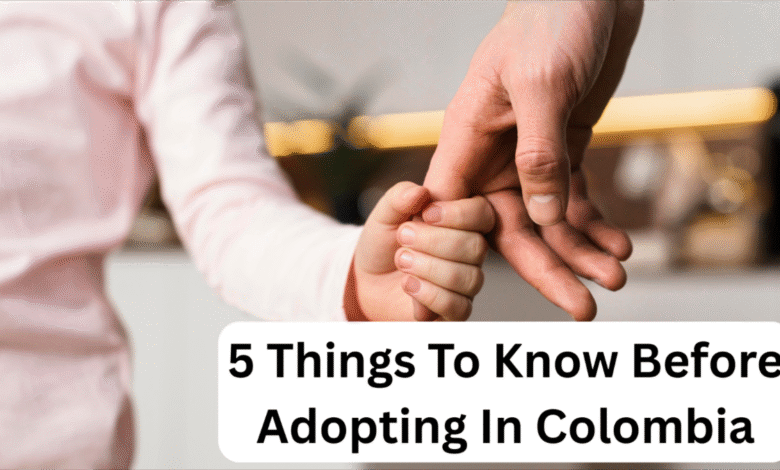5 Things To Know Before Adopting In Colombia

Starting or growing a family through adoption is rarely spontaneous. It’s something that most people take months, even years, to sit with before the timing, funds, and emotional readiness are appropriate.
For those looking into international adoption, Colombia is one of the first countries that comes to mind due to its organized system and progressive society. Although the adoption can be very rewarding, it also demands preparation, patience, and planning.
Colombia’s system of adoption is a deliberately careful process with great concern for the best interests first and foremost. But if you are looking to adopt from Colombia, there are a couple of things that might make your ride smoother or, at the very least, allow you to go into it with eyes open.
Let’s break it down.
1. You’ll Need To Meet Specific Eligibility Criteria

In Colombia adoption begins with meeting a clear set of eligibility standards. You will first need to make sure that you qualify as an adoptive parent in Colombia.
Age is the first of the filters. Potential parents have to be at least 25 years old and at least 15 years older than the child they would like to adopt.
Both married couples and single individuals can apply, but couples must be married or in a long-term, stable relationship for at least two years.
Another factor to consider?
Health—both physical and mental.
Medical testing will be necessary, such as psychiatric testing, and anything in the history of severe disease may call for additional documentation. The goal isn’t to exclude—it’s to ensure the child’s future home is stable for the long term.
So, if you’re just starting out, it’s crucial to obtain all documents needed upfront.
2. Expect a Structured, Child-Centric Process

Colombia is not a first-come, first-served country. The matching is very individualized. There is a centralized process to review homes and match children with families based upon compatibility, needs, and strengths of the family.
That means you’re not going to be selecting a kid; the system will be matching you up with whatever is in both your best interest. Timelines will primarily be based on the age and the health of the child that you are willing to accept.
Sibling groups, children older than six years, or kids with medical needs are normally matched faster. For infants or toddlers, the wait can be longer. What this actually means is: openness and flexibility are key. The more precise your desire, the longer you wait.
3. You’ll Likely Spend Time in Colombia

One of the hallmarks of Colombian adoption is the travel requirement. The family generally takes 3 to 6 weeks in Colombia to complete the bonding stage and legal process. It’s not optional; it’s part of the country’s commitment to child adjustment and assimilation into the family.
During this visit, you’ll be staying with your child and starting to build a relationship in the presence of Colombian authorities. Although technically speaking, it’s an option to have one parent travel independently, it’s highly recommended, if not emotionally necessary, for both parents to share as much of the process as they can.
Some families might have to take an initial trip for interviews or paperwork, if at all. It is important to approach this period with flexibility in terms of mental, emotional, and logistical aspects.
4. Children Eligible for Adoption Vary Widely in Age and Background

One has to be realistic about the children available for international adoption in Colombia today. Although some adoptions are done during times of babies and toddlers, most of the children waiting are older—usually six and up—and/or sibling groups that have to be adopted in groups.
Some of them also have medical, emotional, or developmental issues. It doesn’t imply they don’t deserve a family as much. In fact, it is often the opposite.
But it does imply that potential parents are going to have to be willing and able to learn about trauma-informed care, attachment difficulties, and services their child will need when they enter their home.
Adoption is not looking for the “perfect” child; it is looking for a suitable family for a child who has not had one. The right mindset isn’t just helpful, it’s essential.
5. Post-Adoption Reports and Support Are Required

Adoption does not cease the instant that you get on a plane heading back home. Colombia, as with most countries, has post-adoption reports to confirm that the child is settling and is being well cared for.
They are usually comprised of social worker visits and reports done at intervals throughout the first couple of years. You’ll also need to do pre-adoption training.
It addresses everything from the adoption process to the impact of trauma and institutionalization on child development.
The adoption agencies that handle these adoptions typically offer post-placement services, such as parenting support, referral for counseling, and community networking.
This mandate will initially seem bureaucratic, but it isn’t. It’s a reminder of how serious international adoption is as an ultimate commitment. Most importantly, it gives you an inbuilt group to find support, question things, and gain guidance through the first few years of acclimatization.
Parenting an internationally adopted child is a process, and knowing that there are support systems in place can be the key.
Closing Thought
Adopting in Colombia is not a simple checklist—this is a people-centered process to create safe, lasting families. From eligibility to lifetime support, every step has been designed to protect the child and equip you for the realities of parenting close and far.
If you are contemplating this path, don’t act too quickly. Ask questions. Build your understanding. And once you are ready, know that you will not be going it alone.




